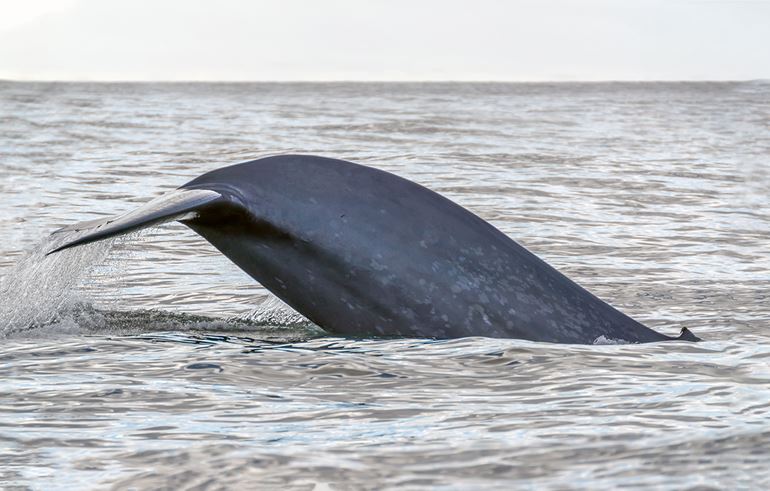Looking for Part 2 of this article? Click here!
From a taxonomic point of view, baleen whales belong to the suborder Mysticeti, which comprises the species that have baleen plates instead of teeth.
With very few, extremely rare exceptions, all baleen whales we see in Pico belong to family Balaenopteridae, whose members are characterised by the so-called throat pleats (or grooves), an anatomical feature that can expand like an accordion when the animal is engulfing water into its mouth to then filter out preys.

Sei whale - the throat pleats, also called throat grooves (photo by Enrico Villa)
In spring, the following baleen whale species utilise our waters as an opportunistic foraging habitat:
- Blue whale (Balaenoptera musculus)
- Fin whale (Balaenoptera physalus)
- Sei whale (Balaenoptera borealis)
- Humpback whale (Megaptera novaeangliae)
(follow the links above to access species-specific sighting charts)
In the North-Atlantic, during their northbound spring migration, these whales travel thousands of km from their low-latitude breeding grounds (tropical or sub-tropical waters) to their high-latitude foraging grounds (places like Norway, Iceland, Greenland, etc.). There, they can finally gorge themselves with food and gain back the weight they have lost in winter, when food is scarce and energy expenditure is high, especially for lactating females.
In this respect, the Azores pitstop is an important feeding opportunity for baleen whales in spring.
If they were humans, we would call it a snack bar!

Fin whale - with its characteristic white lower jaw on the right-hand side (photo by Enrico Villa)
Our baleen whales feed primarily on krill - tiny shrimp-like crustaceans that constitute one of the largest animal biomass on earth and are part of the so-called zooplankton.
Actually, they feed here on a particular species of krill (Meganyctiphanes norvegica) that we at CW Azores identified a few years ago.
Learn more about our scientific research.
Interestingly, Blue whales feed exclusively on krill, whereas Fin, Sei and Humpback whales also feed on schooling fish.

Northern Krill - Meganyctiphanes norvegica (photo by Enrico Villa)
Plankton is a term used to indicate those aquatic organisms who, being unable to make a heading, are at the mercy of the currents.
Baleen whales migrate because their food source is seasonal. Since feeding opportunities are scarce in winter, it is better for them to spend the winter months in waters that, at least, are ideal for giving birth and suckling their young, even if that entails a lot of travelling between the breeding and foraging grounds.
In other words, even taking into account the cost of a migration, they are still better off having two distinct habitats, which they use at different times of the year.

Fin whale about to dive for krill (photo by Enrico Villa)
All in all, our snack bar is a very reliable one. However, there are still significant fluctuations in krill availability within and between seasons.
Some years are exceptionally good, while some others are relatively poor. Furthermore, within any particular season, there are often rather big differences in krill density from March to June.

Blue whale fluking up - i.e. lifting its tail out of the water in preparation to a dive (photo by Enrico Villa)
While it is sometimes possible to see the krill at the water surface, it is unpractical to measure its density day after day in our entire study area.
Luckily, there is an indirect way to estimate food availability for baleen whales using satellite data.
The trick is based on the specific frequencies of light absorbed and reflected by a pigment called Chlorophyll, which is the molecule that gives plants their typical green colour and is also contained in phytoplankton.
Chlorophyll allows plants and phytoplankton to capture solar radiation through a chain of chemical transformations known as photosynthesis. The energy from the sun is then used by all these organisms to build their own food (sugars), using carbon dioxide (CO2) as molecular bricks in the process.
In the ocean, plants do not play a significant role in primary productivity, the reason being that true plants have roots. Just imagine a plant setting roots at depths greater than 20-30 metres: it would not get enough light to survive!
The major contributor to primary productivity in the ocean is thus phytoplankton - unicellular algae that do exactly the same job plants do on land, but they are able to move in the water column to find the ideal conditions for light absorption.

Chlorophyll data from 2008 to 2020 in the waters around Pico, Faial and S. Jorge.
Using a technique called satellite remote sensing, it is possible to estimate chlorophyll density is in any area of the ocean, which is proportional to the amount of phytoplankton that contains it. Since krill feeds on phytoplankton, given a delay of about 30 days, in areas where chlorophyll concentration was high, krill density will also be high. The delay is due to the need of krill individuals to feed copiously before they can reproduce and increase their abundance.
In the second part of this article we will check whether the chlorophyll peaks correlate with the peaks of the two species of baleen whales we see more often: Blue whales and Fin whales.